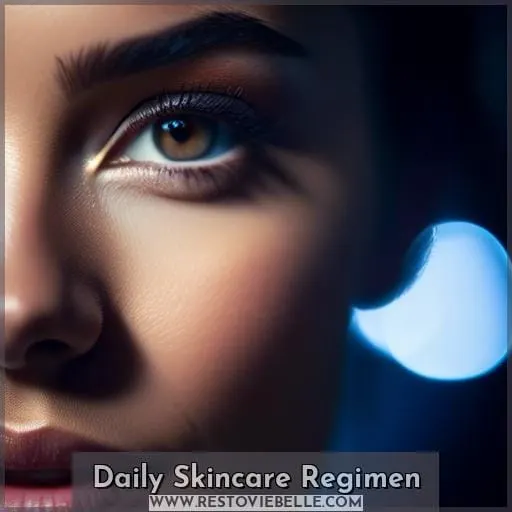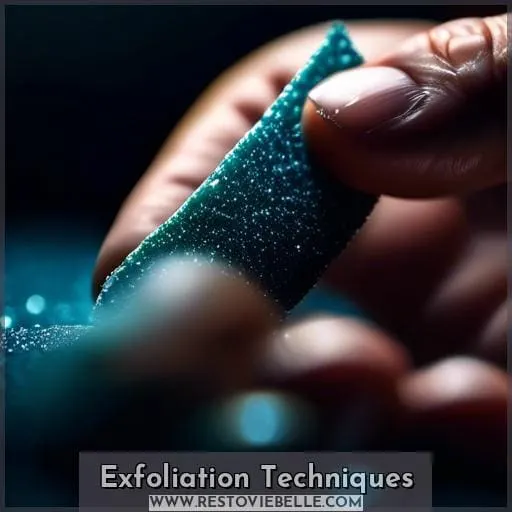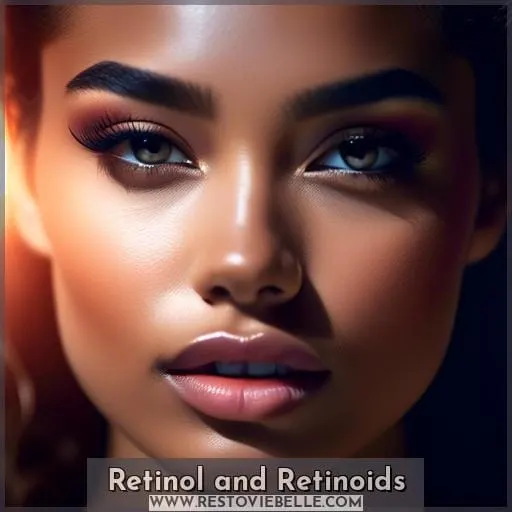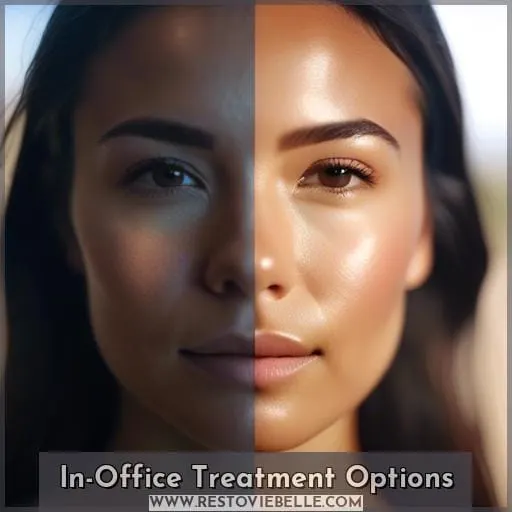This site is supported by our readers. We may earn a commission, at no cost to you, if you purchase through links.
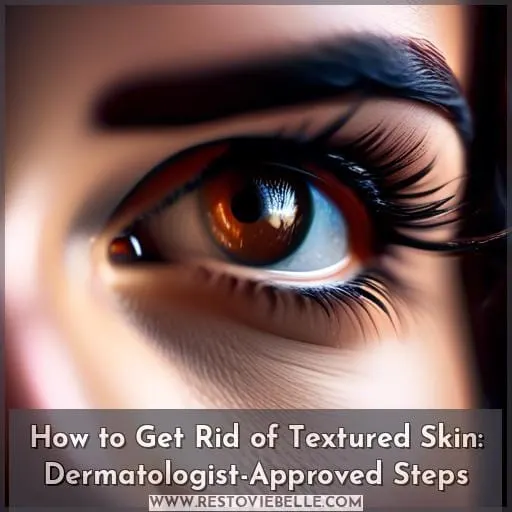 Struggling with textured skin can feel like a never-ending battle, but you’re not alone. This guide dives into dermatologist-approved steps to smooth out those frustrating bumps and uneven patches.
Struggling with textured skin can feel like a never-ending battle, but you’re not alone. This guide dives into dermatologist-approved steps to smooth out those frustrating bumps and uneven patches.
From understanding the root causes to adopting a tailored skincare regimen, we’ll cover everything you need to know. You’ll learn about the power of exfoliation, the importance of hydration, and why sun protection is non-negotiable.
Ready to achieve that silky, glowing complexion? Let’s get started.
To get rid of textured skin, regular exfoliation with products containing AHAs or BHAs and using retinol can help promote new skin growth and reduce uneven texture.
Table Of Contents
- Key Takeaways
- Understanding Textured Skin
- Daily Skincare Regimen
- Exfoliation Techniques
- Sun Protection Measures
- Vitamin C Serums
- Retinol and Retinoids
- In-Office Treatment Options
- Lifestyle Adjustments
- Professional Consultation
- Frequently Asked Questions (FAQs)
- Can textured skin be completely eliminated, or is it possible to only minimize its appearance?
- Are there any specific dietary recommendations or supplements that can help improve textured skin?
- How long does it typically take to see noticeable results when using retinol or retinoids for textured skin?
- Are there any specific exercises or massage techniques that can benefit textured skin on the body?
- Can stress and mental health impact the texture of the skin, and if so, what are some strategies to address this?
- Conclusion
Key Takeaways
- Regular exfoliation with chemical exfoliants such as glycolic, lactic, or salicylic acid can help reduce the appearance of textured skin by dissolving the bonds between dead skin cells.
- Maintaining a consistent skincare routine that includes cleansing, moisturizing, and protecting the skin with a broad-spectrum sunscreen of at least SPF 30 is essential for managing textured skin.
- Professional treatments like chemical peels, as well as consulting with a dermatologist for personalized care, can be beneficial for persistent textured skin issues.
- Incorporating products that support collagen production, such as retinoids, and using anti-inflammatory ingredients can improve skin texture and tone.
Understanding Textured Skin
Understanding the nuances of textured skin is crucial for anyone looking to achieve a smoother complexion.
Textured skin is characterized by unevenness such as bumps, dry patches, or scarring. It can stem from various causes including genetics, environmental damage, and skin conditions like acne.
Fortunately, with the right approach, improving your skin’s texture is achievable. This includes incorporating gentle exfoliation, targeted treatments like vitamin C and retinol, and consistent use of sunscreen.
Identifying Uneven Texture
Identifying uneven skin texture involves recognizing areas where your skin feels bumpy, rough, or irregular compared to the rest of your face. This step is crucial for tailoring your skincare routine towards skin tone correction, enhancing skin hydration, and minimizing pores.
Effective management also focuses on dark spot removal and wrinkle reduction. By understanding the characteristics of textured skin, including uneven skin texture, fine lines, and wrinkles, you can adopt a proactive approach.
This knowledge empowers you to select treatments and products specifically designed to smooth out irregularities and improve the overall appearance of your skin.
Common Causes
Why does your skin sometimes feel uneven or bumpy? Various factors contribute to textured skin, including aging, which leads to a loss of elastin and collagen, making the skin appear less smooth. Dry skin conditions, such as psoriasis or keratosis pilaris (KP), can cause rough, flaky patches.
Persistent acne can leave behind pitted scars, while sun exposure breaks down collagen and causes dryness, further exacerbating skin texture issues. Genetics also play a significant role in determining skin texture and pore size.
Additionally, skin conditions like eczema, psoriasis, and rosacea can lead to uneven texture and dryness.
- Acne Scarring: Deep, pitted scars from previous acne outbreaks can create a lasting uneven skin surface.
- Sun Damage: UV radiation accelerates collagen breakdown, leading to wrinkles and exacerbating uneven skin texture.
- Genetic Factors: Your genetic makeup influences pore size and skin’s natural elasticity, affecting overall texture.
Daily Skincare Regimen
To maintain a healthy complexion and combat textured skin, it’s essential to incorporate cleansing and moisturizing into your daily skincare routine.
Cleansing helps remove impurities and excess oils that can contribute to skin texture issues, while moisturizing ensures your skin stays hydrated. This hydration can prevent the overproduction of sebum that often leads to clogged pores and further textural irregularities.
A consistent regimen that includes these steps can significantly improve your skin’s appearance and health over time.
Importance of Cleansing
Ensure you’re cleansing your face both morning and night to remove impurities and prevent buildup that can lead to textured skin. Cleansing is the cornerstone of any effective skincare routine, as it clears away dirt, excess oil, and dead skin cells, paving the way for healthier, smoother skin.
Opt for gentle cleansers that don’t strip your skin of its natural oils, which can lead to dryness and irritation. Consider incorporating double cleansing in the evening, especially if you wear makeup or sunscreen.
This method starts with an oil-based cleanser to dissolve sebum and makeup, followed by a water-based cleanser to remove any remaining impurities and refresh the skin.
For those with sensitive or acne-prone skin, foaming cleansers with ingredients like tea tree oil can provide deep cleaning without over-drying. Remember, the right cleansing techniques and products can significantly impact your skin’s texture and overall health.
Moisturizing Benefits
One can’t overstate the importance of moisturizing as part of a daily skincare regimen; it’s essential for maintaining the skin’s hydration levels and preventing the dryness that can lead to a textured appearance.
Regularly moisturizing dry skin supports a robust skin barrier, crucial for preventing moisture loss and protecting against irritants. By soothing irritated skin and balancing skin pH, moisturizers help to promote a smooth, even complexion.
Hydration is the key to warding off dehydrated skin, which often exacerbates texture issues. Thus, integrating moisturizing into your skincare routine is a pivotal step towards achieving and maintaining a healthy, refined skin texture.
Exfoliation Techniques
To address textured skin through exfoliation, it’s essential to understand the role of chemical exfoliants and the recommended frequency of their use.
Chemical exfoliants, such as glycolic, lactic, or salicylic acid, work by dissolving the bonds between dead skin cells, promoting cell turnover and revealing smoother skin beneath. While they can be highly effective, it’s crucial not to over-exfoliate, as this can damage the skin’s protective barrier and lead to irritation.
Most experts suggest using chemical exfoliants one to three times per week, depending on your skin type and tolerance.
Chemical Exfoliants
Following your daily skincare regimen, incorporating chemical exfoliants can further enhance your skin’s texture and appearance. By using these specialized acids, you’re able to gently remove dead skin cells, promoting a smoother and more radiant complexion.
- Chemical Exfoliation: Choose products with glycolic, lactic, or salicylic acid to boost cell turnover and reveal fresher skin.
- Frequency of Use: Start with once a week, adjusting based on skin sensitivity to avoid over-exfoliation.
- Product Selection: Consider professional treatments like chemical peels for deeper exfoliation, and complement with retinols and vitamin C for optimal skin health.
Frequency of Exfoliation
To maintain the health and appearance of your skin, it’s important to find the right balance in your exfoliation routine. Dermatologists suggest that you should exfoliate your face 1–3 times per week, depending on your skin type and the exfoliation method used.
For those with oily or acne-prone skin, exfoliating up to three times a week may be beneficial, especially with chemical exfoliants like salicylic acid. However, if you have dry or sensitive skin, limiting exfoliation to once a week or even less frequently is advisable to avoid irritation.
| Exfoliation Type | Recommended Frequency |
|---|---|
| Chemical | 1-3 times per week |
| Mechanical | 1-2 times per week |
| Physical | 1-2 times per week |
| Oily Skin | Up to 3 times per week |
| Dry/Sensitive Skin | Once a week or less |
Sun Protection Measures
To effectively combat textured skin, incorporating sun protection measures into your daily skincare routine is crucial.
Choosing the right SPF is essential to prevent collagen breakdown, which is a key factor in maintaining smooth skin.
Applying a broad-spectrum sunscreen with an SPF of 30 or higher every day, even on cloudy days, can significantly reduce the risk of UV-induced damage, keeping your skin healthier and more resilient against texture irregularities.
Choosing the Right SPF
Why settle for less when you can protect your skin with the right sunscreen? Choosing a sunscreen with broad-spectrum protection and an SPF of at least 30 is essential, as it will guard against both UVA and UVB rays, which can exacerbate skin texture issues.
- SPF labels guide you in selecting effective protection.
- SPF reapplication is crucial, especially after swimming or sweating.
- SPF types cater to different skin concerns, including sensitive skin or rosacea.
- UVA vs UVB: Understanding the difference helps tailor your sun protection strategy.
- SPF myths often discourage use; know the facts to ensure adequate protection.
Preventing Collagen Breakdown
How then, can you ensure your skin’s collagen is protected from the breakdown caused by UV exposure? It’s crucial to incorporate a broad-spectrum sunscreen with an SPF of at least 30 into your daily skincare routine, as it shields your skin from the full range of UVA and UVB rays known to contribute to photoaging.
| Factor | Impact on Skin |
|---|---|
| Collagen Synthesis | Enhances skin firmness and reduces wrinkles |
| Elastin Production | Improves skin elasticity |
| Matrix Metallopeptidases | Prevents degradation of collagen and elastin |
| Topical Antioxidants | Protects against free radicals and supports collagen integrity |
Vitamin C Serums
Vitamin C serums are a cornerstone in the fight against textured skin, offering a range of benefits that can lead to a smoother, more radiant complexion.
These serums work by providing potent antioxidant protection, brightening the skin, and stimulating collagen production.
When used consistently, vitamin C serums can not only improve the appearance of fine lines and dark spots but also enhance the skin’s overall texture and tone.
Antioxidant Properties
With an array of benefits for your skin, vitamin C serums are a cornerstone in the fight against textured skin, offering potent antioxidant properties that can brighten your complexion and stimulate collagen production.
- Antioxidant Protection: Shields skin from environmental aggressors, reducing the risk of scarring, blackheads, whiteheads, and milia.
- Sun Damage Prevention: Vitamin C mitigates the effects of UV exposure, helping prevent the collagen breakdown that leads to textured skin.
- Collagen Breakdown Reduction: By stimulating collagen production, vitamin C serums not only improve skin’s elasticity but also diminish the appearance of fine lines and uneven texture, paving the way for smoother, more radiant skin.
Brightening Effects
In the context of the antioxidant properties of vitamin C serums, you’ll find that these serums not only help in protecting your skin from damaging free radicals but also have significant brightening effects.
By inhibiting melanin production, vitamin C serums can reduce the appearance of dark spots and hyperpigmentation, giving your complexion a more even and radiant look.
The benefits of vitamin C extend beyond just antioxidants in skincare; they’re pivotal in serums for textured skin, brightening dull skin, and effectively fading dark spots, ensuring your skin achieves a luminous, healthy glow.
Retinol and Retinoids
Retinol and retinoids are your allies in the battle against textured skin, offering a dual approach to enhancing cell turnover and delivering anti-aging benefits.
These vitamin A derivatives work by promoting the renewal of skin cells, which can help smooth out uneven textures and reduce the appearance of fine lines and wrinkles.
By incorporating retinol or prescription-strength retinoids into your skincare routine, you’re taking a significant step towards achieving a clearer, more youthful complexion.
Enhancing Cell Turnover
To improve your skin’s texture, incorporating retinol and retinoids into your skincare routine can effectively enhance cell turnover. These potent ingredients stimulate the renewal of skin cells, promoting a smoother and more even complexion.
Retinol and retinoids work by accelerating the shedding of old skin cells, revealing fresher skin underneath. This process helps reduce the appearance of fine lines, wrinkles, and uneven texture.
Additionally, ensuring proper hydration, maintaining a balanced diet rich in nutrients that support cell turnover, and adopting a healthy lifestyle can further enhance the benefits of these ingredients for optimal skin rejuvenation.
Anti-Aging Benefits
Revitalization of your skin’s appearance is a key benefit of incorporating retinol and retinoids into your skincare routine, as these derivatives of Vitamin A are renowned for their ability to enhance cell turnover and stimulate collagen production.
- Combat Collagen Loss: They significantly reduce the signs of aging by replenishing collagen levels.
- Diminish Fine Lines: Regular use can smooth out early signs of aging such as fine lines.
- Prevent Wrinkles: With consistent application, they help prevent the formation of deeper wrinkles.
- Elastin Breakdown Resistance: These agents aid in fortifying the skin’s elasticity.
- Anti-Aging Effects: Overall, they provide a comprehensive anti-aging solution for a more youthful complexion.
In-Office Treatment Options
When addressing textured skin concerns, dermatologists often recommend in-office treatments like chemical peels, laser resurfacing, and microneedling.
These procedures can help improve skin texture by exfoliating, stimulating collagen production, and promoting skin renewal.
Consulting with a board-certified dermatologist can guide you towards the most suitable in-office treatment for your specific textured skin issues.
Chemical Peels
While retinol and retinoids enhance cell turnover and provide anti-aging benefits, chemical peels offer a more intensive solution for textured skin by removing the outermost layers and promoting collagen production.
If you’re considering this option, you’ll find that a chemical peel can significantly improve the appearance of your skin by addressing issues such as fine lines, wrinkles, acne, and uneven pigmentation.
Chemical peel types, peel preparation tips, post-peel care routine, peel downtime expectations, and chemical peel results timeline are essential considerations.
Laser Resurfacing
When considering options for addressing textured skin, laser resurfacing emerges as a powerful in-office treatment that can significantly improve skin texture and appearance.
- Laser Technology: Precisely removes the outer layer of skin, promoting new growth.
- Laser Rejuvenation: Stimulates underlying skin, enhancing tone and tightness.
- Laser Scar Removal: Targets and diminishes the appearance of scars, contributing to a smoother complexion.
Microneedling
Among the array of in-office treatments for textured skin, microneedling stands out for its ability to rejuvenate the skin from within.
By creating tiny punctures on the skin’s surface, this procedure triggers the body’s natural healing process, leading to the production of collagen and elastin. These key proteins are essential for maintaining the skin’s structure and elasticity, making microneedling an effective solution for various skin concerns, including fine lines, wrinkles, and acne scars.
Additionally, microneedling can enhance the absorption of skincare products, allowing for deeper penetration and increased efficacy. With minimal downtime and the potential for significant improvements in skin texture and appearance, microneedling offers a promising option for those seeking to revitalize their complexion.
Lifestyle Adjustments
Incorporating lifestyle adjustments into your routine can significantly impact the appearance of textured skin.
Focusing on diet and nutrition, alongside the benefits of regular exercise, can help improve your skin’s overall health and texture.
These changes not only support your skin’s natural repair processes but also enhance the effectiveness of topical treatments and professional procedures you might be considering for smoother skin.
Diet and Nutrition
After exploring in-office treatments for textured skin, it’s crucial to recognize the role of diet and nutrition in maintaining a healthy complexion.
You’ll find that incorporating certain foods into your meals can significantly enhance your skin’s texture and overall health. Foods rich in omega-3 fatty acids, such as fatty fish, have been shown to moisturize the skin and reduce inflammation, which can lead to a smoother appearance.
Additionally, vegetables like broccoli contain sulforaphane, which may protect against premature aging and skin cancer. Vitamins E and C, found in avocados and tomatoes, are also essential for protecting your skin from oxidative damage and supporting collagen production, which is vital for skin strength and elasticity.
Regularly including these nutrient-dense foods in your diet can contribute to a more even skin texture and may even help prevent future skin issues.
Exercise Benefits
Regular exercise can significantly contribute to maintaining a healthy, vibrant skin texture by promoting blood circulation and reducing stress. This, in turn, can help to minimize issues like acne and eczema. By integrating exercise habits into your daily routine, you’re not just enhancing cardiovascular health but also improving muscle tone.
The release of endorphins during physical activity acts as a natural stress reliever, further preventing stress-related skin problems. This combination of benefits from regular exercise ensures your skin receives the nourishment and support it needs to stay smooth and resilient, reflecting your inner health on the outside.
Professional Consultation
If you’ve tried various treatments for textured skin without success, it’s time to consult a dermatologist.
They can offer personalized treatment plans tailored to your specific skin concerns.
This step ensures you receive the most effective and safe options for improving your skin’s texture.
When to See a Dermatologist
While you might diligently follow a skincare regimen to manage textured skin, it’s essential to consult a dermatologist if you notice persistent issues or severe symptoms.
A professional can offer tailored advice on scarring treatments, recommend skincare products that align with your skin’s unique needs, and prescribe acne medication options if necessary. They’re also equipped to assess for hormonal imbalances that might be contributing to your skin’s texture.
Considering professional microdermabrasion or other in-office procedures? Your dermatologist will guide you through these options, ensuring you choose the most effective and safe route for your skin’s health.
Personalized Treatment Plans
Seeking a dermatologist’s expertise for a personalized treatment plan is a crucial step in addressing your unique skin concerns effectively. Dermatologists can offer tailored advice and treatments based on an in-depth understanding of your skin’s condition, ensuring that you receive the most appropriate care for your specific needs.
- Personalized Treatment Plans: Focus on individual skin concerns with a plan that targets your unique issues.
- Tailored Skincare Routine: Receive specific product recommendations to enhance your daily regimen.
- Professional Advice: Gain access to expert insights and advanced treatments not available over the counter, ensuring a comprehensive approach to your skincare.
Frequently Asked Questions (FAQs)
Can textured skin be completely eliminated, or is it possible to only minimize its appearance?
Textured skin can’t be completely eliminated due to natural factors like pores and genetics.
However, its appearance can be significantly minimized with treatments like retinol, exfoliation, and professional dermatological procedures.
Are there any specific dietary recommendations or supplements that can help improve textured skin?
Eating a diet rich in fruits and vegetables can support skin health.
Consuming omega-3-rich seafood is beneficial for the skin.
Including healthy fats like avocado in your diet may improve textured skin.
How long does it typically take to see noticeable results when using retinol or retinoids for textured skin?
You’ll typically start seeing improvements in skin texture within 2 to 6 weeks when using retinol or retinoids.
More significant changes like reduced fine lines may take several months.
Are there any specific exercises or massage techniques that can benefit textured skin on the body?
Regular exercise can enhance your skin’s appearance by increasing blood flow, which nourishes skin cells and carries away waste products.
Additionally, facial massage techniques can promote circulation and lymphatic drainage, leading to a smoother skin texture.
Remember to stay hydrated and moisturize after your workouts.
Can stress and mental health impact the texture of the skin, and if so, what are some strategies to address this?
Yes, stress can affect your skin’s texture by increasing cortisol levels. This, in turn, heightens inflammation and exacerbates conditions like acne, eczema, or psoriasis.
To manage stress, try meditation, yoga, regular exercise, and ensure proper sleep.
Conclusion
Bidding adieu to textured skin isn’t a myth—it’s a mission possible! By embracing a daily skincare routine, exfoliating regularly, and never skimping on sun protection, you’re on the right track.
Don’t forget the dynamic duo of vitamin C and retinol to brighten and renew. If bumps persist, a dermatologist can tailor treatments just for you.

